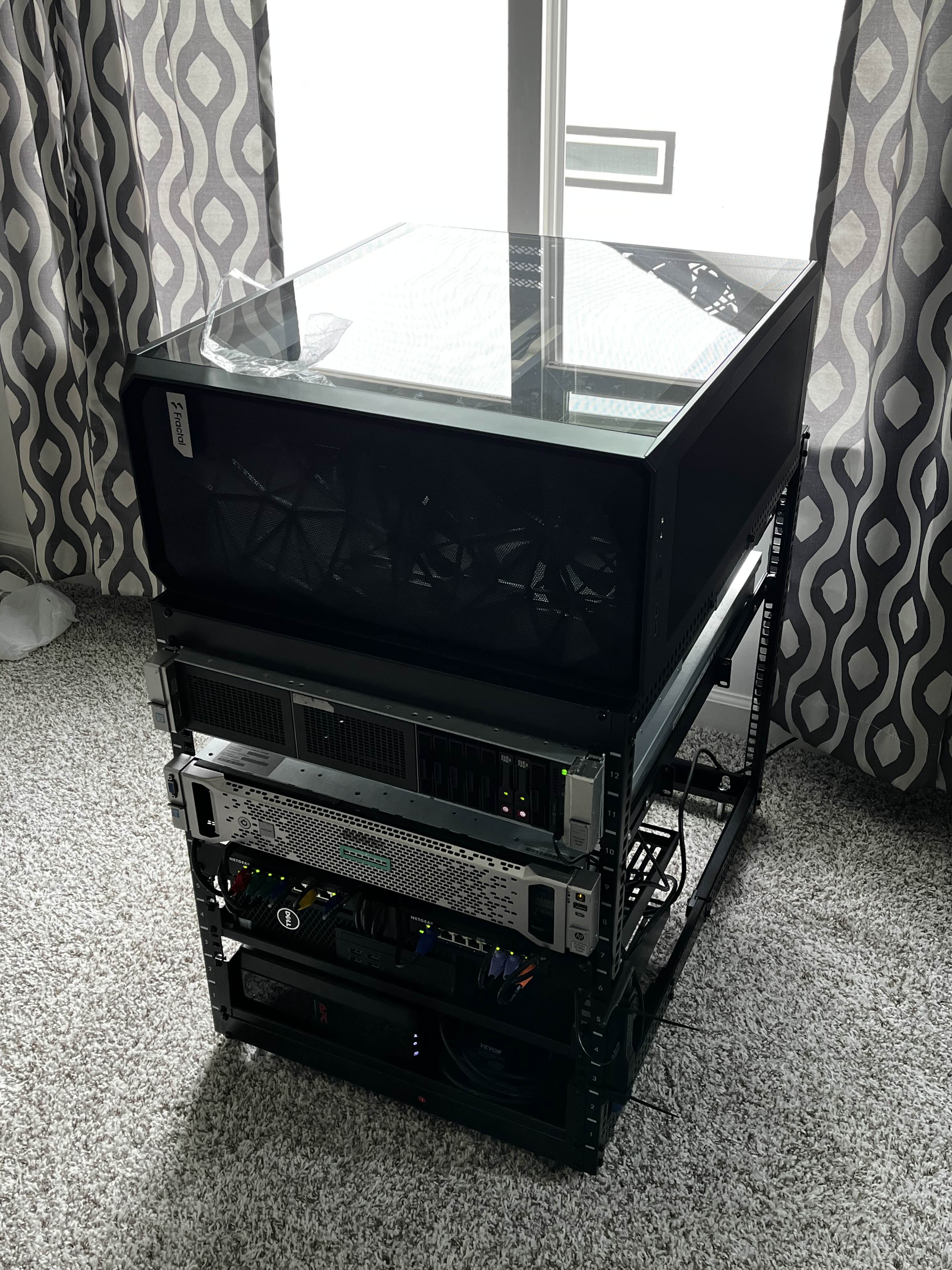$ Sai Coumar
~ Hi everyone! I'm Sai and I'm a Ph.D. student in Computer Science at Purdue University with CoMMA Lab.
My research interests are primarily in systems optimized motion planning in robotics, but I'm also particularly interested in distributed networks, machine learning, and computational linear algebra and statistics.
I'm also a big fan of retro gaming and emulation and I love Final Fantasy!
$ Currently Working On:
~ I'm currently building my homelab's compute cluster!
~ For the last year, I have slowly been accumulating recycled hardware to build my a small distributed cluster to help me with systems research! So far I have a HP DL380p Gen 9, a HP DL380p Gen 8,
a Dell Precision 3420, a Dell Precision t5810, a Raspberry Pi Zero 2 W, a custom built HPC with 4 A5000 GPUs, a UPS for backup power, and two switches in a custom fabricated enclosure. I run critical services such as VPNs and DNS on the Dell Precision 3420, non-critical services and various sandbox virtual machines on my DL380p Gen 9, a NAS on my DL380p Gen 8, and a GPU-accelerated compute node on my HPC Server.
This cluster features a variety of software, from hypervisors such as Proxmox and VMware ESXi, to various open-source services such as Pi-Hole, TrueNAS, Jellyfin, and more. My network topology has been customized with a tiered distributed memory hierarchy and various optimizations for redundancy and performance under resource constraints.
~
Many people have asked me why I would go through the effort of putting together such a hefty cluster - especially when I barely push it past 5% load on most days! Truthfully, much of this cluster happened to accidentally fall into my hands.
I have been quite fortunate to have acquired all of these servers from e-waste and decommisioned industry setups and I absolutely love being able to squeeze a little bit of life out of them. The major exception to this is my HPC,
which I consider to be a bit of a historical relic. My HPC, Sparta, is fitted with 4x NVIDIA A5000 GPUs with NVLink bridges and SLI. These features have been abandoned in favor of enterprise grade NVSwitches in data centers rendering later generations essentially inaccessible to workstation builds. This system took quite a while to acquire parts for, but I loved spending the time to plan it all out and put it together.
~
As a Ph.D. student in robotics with a specialization systems optimization these resources have become invaluable to my work. Having a personal network at my disposable provides me avenues to prototype concepts tailored to distributed systems and very specific technologies that I fear has been
rather abstracted from many of my peers in the form of research clusters and cloud compute. I can't count the number of times I've been able to quickly deploy an entire system from scratch to test certain tools on controlled clean virtual machines in the little time this clsuter has been up, nor can I quantify the value of having self hosted services to aid my workflow.
Additionally, I find getting down and dirty with the hardware provides me a unique perspective of the advanced systems I work with professionally.
$ Pinned Project:
~ I'm happy to present Bastion! Bastion is my unified SSH manager centralizing SSH connections with better pubkey management for LAN networks based on the concept of ProxyJumping through fortified bastion hosts.
~ I was inspired to make Bastion after studying systems and networking architectures designed for high security environments, such as federal and military networks.
The core concept behind bastion is to design a robust communication schematic where all nodes can communicate through fortified hosts, minimizing the attack surface of the network while still allowing for efficient communication between nodes.
Unfortified nodes can must authenticate with the bastio host before being allowed to communicate with peers on the network. If nodes are compromised they can easily be quarantined by the bastion host from the rest of the network and prevent more nodes from being compromised.
While this puts a lot of trust in the bastion host, it makes it far easier for administrators to make an entire network resilient by focusing security efforts on a few bastion hosts rather than every node on the network.
Additionally, multiple bastion hosts can be deployed to ensure redundancy and load balancing.
~ In practice, Bastion would only very rarely be actually useful. The core functionality of managing SSH permissions and accounts can be handled by a domain controller with password locking mechanisms.
SSH also has a built in proxyjump feature that allows users to send their connection through other hosts, however Bastion fundamentally reworks the implementation to shift the trust model to the bastion host rather than the nodes in a network.
In WAN networking this wouldn't make much sense since you typically trust your endpoints more than random intermediary hosts on the Internet, but in LAN environments where nodes could easily be compromised, a trust model that shifts trust to fortified hosts makes more sense.
The implementation was a rewarding learning experience as I had to fundamentally rework how SSH connections are made and managed, and I ended up learning many of the internal workings of SSH along the way. I don't intend to expand Bastion further, however I am interested in applying some of these concepts to multi-agent drone robotics for resilient SWARM networks in the future.


